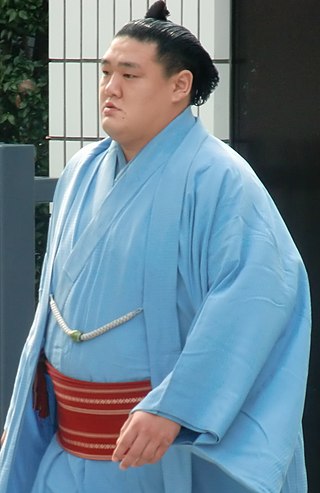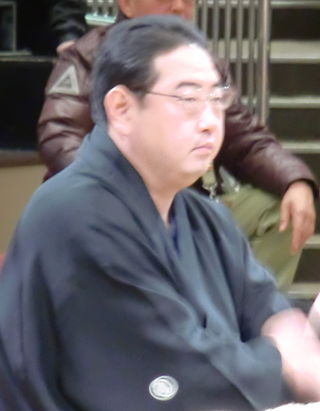Shunketsu Yūji is a former sumo wrestler from Misato, Saitama, Japan. The highest rank he reached was maegashira 12.

Tosanoumi Toshio, is a former sumo wrestler. He first reached the top division of professional sumo in 1995, winning 13 special prizes and earning 11 kinboshi or gold stars for defeating yokozuna over his long career. The highest rank he reached was sekiwake. He retired in 2010 to become a coach at his stable, Isenoumi stable under the name of Tatekawa.

Ōtsukasa Nobuhide is a former sumo wrestler from Miki, Hyōgo, Japan. A former amateur champion, he made his professional debut in 1993. The highest rank he reached was maegashira 4. He retired in March 2009 and is now a sumo coach.

Hōchiyama Kōkan is a former sumo wrestler from Hirosaki, Aomori Prefecture, Japan. He joined professional sumo in 2000. His highest rank was maegashira 14, achieved in 2006. After illness saw him demoted to the third makushita division in 2008, he returned to the second highest jūryō division in 2010 and the top makuuchi division in September 2011. After winning the sandanme division he had just been demoted to in November 2013, he chose to retire. He is now a coach at Sakaigawa stable under the name of Tatsutagawa (立田川).

Kitazakura Hidetoshi, born December 15, 1971, as Hidetoshi Mukō is a former sumo wrestler from Asakita ward, Hiroshima City, Japan. His highest rank was maegashira 9. He is the elder brother of Toyozakura, also a top division wrestler. He was a popular figure with sumo fans. He is now a stable master and elder of the Japan Sumo Association under the name Shikihide-oyakata.

Jūmonji Tomokazu is a former sumo wrestler from Aomori, Japan. Joining the professional ranks in 1992, he reached the top division in 2000 and was ranked there for 34 tournaments until 2007. His highest rank was maegashira 6. He was forced to retire in April 2011 after an investigation by the Japan Sumo Association found him guilty of match-fixing.

Ryūhō Masayoshi is a former sumo wrestler from Nakagami, Okinawa, Japan. His highest rank was maegashira 16.

Tamaasuka Daisuke is a former sumo wrestler from Atsuta-ku, Nagoya, Aichi Prefecture, Japan. He made his professional debut in March 1998. His highest rank was maegashira 9. He was well known for moving between the top makuuchi division and the second jūryō division on several occasions. He won two makushita and two jūryō division championships. He retired in September 2016 and is now a sumo coach.

Ōshio Kenji was a Japanese sumo wrestler from Kitakyushu. His highest rank was komusubi. His career lasted twenty-six years, from 1962 until 1988, and he holds the record for the most bouts contested in professional sumo. After his retirement at the age of 40 he became an elder of the Japan Sumo Association and set up Shikihide stable in 1992. He left the Sumo Association upon turning 65 in 2013. He died in 2024.
Oginishiki Yasutoshi is a former sumo wrestler from Ichikawa, Chiba Prefecture, Japan. His highest rank was komusubi. His father and brother were also sumo wrestlers. He is now a coach at Dewanoumi stable.
Ōzutsu Takeshi is a former sumo wrestler from Mie, Japan. Beginning his professional career in May 1971, he was ranked in the top makuuchi division continuously from March 1979 to January 1992, and his record of 1170 consecutive bouts there is the second best in history after Takamiyama. His highest rank was sekiwake. He was runner-up in one tournament and earned ten kinboshi or gold stars for defeating yokozuna. He also won four sanshō or special prizes. He wrestled for Taihō stable and after his retirement in May 1992 he worked there as a coach before leaving the Japan Sumo Association in 2008.

Tochinowaka Michihiro is a former sumo wrestler from Hyogo, Japan. His father is a Zainichi Korean and his mother is a Korean immigrant. He made his professional debut in 2007 and steadily rose through the ranks. His highest rank was maegashira 1.
Tamaryū Daizō is a former sumo wrestler from Nagasaki, Japan. He made his debut in 1970, retiring in 1992. He was one of the lighter sekitori wrestlers. His highest rank was komusubi. He was a member of Kataonami stable.

Oginohana Akikazu is a former sumo wrestler from Ichikawa, Chiba, Japan. He made his professional debut in July 1983, and reached the top division in January 1990. His highest rank was maegashira 2. He retired in July 1998. He is the son of former sekiwake Oginohana Masaaki and the elder brother of former komusubi Oginishiki. Since 2014 he has been the head of the Dewanoumi stable.
Dewanohana Yoshitaka is a former sumo wrestler from Nakasato, Aomori, Japan. He made his professional debut in July 1974, and reached the top division in November 1977. His highest rank was sekiwake. He retired in January 1988 and became an elder in the Japan Sumo Association under the name Dekiyama. Upon reaching the mandatory retirement age of 65 in May 2016 he was re-hired by the Sumo Association for five years as a consultant.

Tenkaihō Takayuki is a retired sumo wrestler from Tamana, Kumamoto, Japan. He made his professional debut in January 2007, and reached the top division in January 2012. His highest rank was maegashira 8. He won one sandanme championship. He retired in March 2019 to become a coach in the Japan Sumo Association.

Wakasegawa Yoshimitsu was a sumo wrestler from Sakata, Yamagata, Japan. He made his professional debut in 1978, reaching the top makuuchi division for the first time in 1983. His highest rank was maegashira 1. He retired in 1992 and worked in the restaurant business after leaving sumo.
Ryūkōzan Kazuto, born Kazuto Miyata, was a sumo wrestler from Sakai, Osaka, Japan. He made his professional debut in March 1983, and reached the top makuuchi division in January 1990, alongside his stablemate Oginohana. His highest rank was maegashira 5. He died of a heart attack after only one tournament in the top division.

Amakaze Kōichi is a Japanese professional sumo wrestler from Kotohira, Kagawa. He made his professional debut in March 2007, joining Oguruma stable, and reached the top makuuchi division in September 2016. His highest rank has been maegashira 13. He has one jūryō division championship or yūshō.

Daishōhō Kiyohiro is a Mongolian professional sumo wrestler from Ulaanbaatar. He began his professional sumo career in 2013 at the age of eighteen. His highest rank to date has been maegashira 9. He wrestles for the Oitekaze stable.














